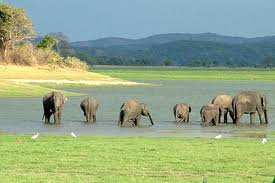
Maduru Oya National Park is located in the Dry zone and is
314 km away from Colombo It is situated by Kuda Sigiriya a great eco location
yet to be explored by travelers to Sri Lanka.
Maduruoya well known for its elephant habitat. Other than
elephant, leopard, sloth bear, sambhur, spotted and barking deer, wild boar and
wild buffalo are also found here. Torque Macaque, Purple face leaf monkey and
nocturnal slender Loris is also found in the park. Lesser Adjutant, Wooly
necked stork, open bill, painted stork, Racket tailed Drongo, Yellow fronted
barbet, Sri Lanka Junglefowl & Spurfowl are among the over 100 species of
birds found within the park.

Ruins at Henanigala, Kudawila, Gurukumbura, Uluketangoda, Werapokuna and several other places include ancient Buddhist shrines, temples, dagobas, statues, devales and hermitages from different eras in Sri Lankan history. An ancient sluice dating prior to the 6th century BC was discovered recently on the old breached earthen bund of the Maduru Oya. Early Brahmin inscriptions dating from the 3rd century BC are found at Kandegamakanda. Vestiges of the Veddhas, an aboriginal tribe believed to be descended from King Vijaya and the Yaksha (demon) princess Kuveni, are to be traced in the traditional lifestyles of a few families in Dambana.
.jpg) One of animal it found on dry zone forest habitats in Sri lanka Sloth bear. It has thick coats and sickle like claws. This is the only member of the bare family found in Sri lanka. This animal have main problem the human encroach the there's living places.
One of animal it found on dry zone forest habitats in Sri lanka Sloth bear. It has thick coats and sickle like claws. This is the only member of the bare family found in Sri lanka. This animal have main problem the human encroach the there's living places..jpg)
.jpg)
.jpg)

.jpg)
.jpg)















